I’ve started to combine all the Fantasy Safari posts of each book in a single page and put them on an index page, which you find here and in the menu bar above. This is probably easier than searching for all the original posts separately.
Tag: fantasy safari
Fantasy Safari: Monsters of Faerûn (D&D 3rd ed.), Part 2
More Forgotten Realms goodness:
The Chosen One is essentially a ghoul who causes temporary Constitution damage instead of paralysis. It doesn’t say why it is named that way, and only that chosen ones are made by the Red Wizards of Thay as servants. Very weak entry. (Variant Ghoul +1)
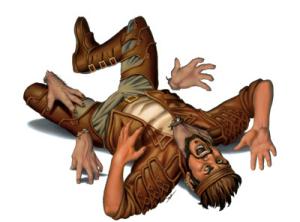
Crawling Claws, on the other hand, are awesome. They also are the other hand, as they are created only from left hands taken from dead or even living humanoids. They don’t have any special abilities or fancyful backstory. They are just animated hands that crawl around and attack people, which is cool and fun enough by itself. Creating one is only a 3rd level spell and each claw is automatically under the command of its creator. For some reason the spell is also evil, even though nothing about it indicates why. Ah well, alignment! Never made any sense, never will.
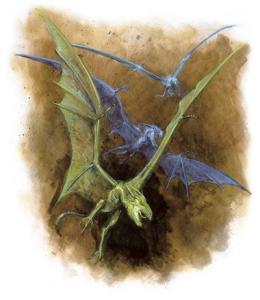
I am not sure where the idea of monsters being the creation of crazy wizards comes from, but it might very well have been Forgotten Realms. Darkenbeasts are somewhat reptilian and bat like monsters created from ordinary small animals by the Red Wizards. As their name hints at, darkenbeasts can not tollerate sunlight and after each ten minutes of exposure there is a 25% chance that the magic will end and the monster return back into an animal. In addition to being winged servants with a high resistance to magic, a wizard can also use a darkenbeast to store a spell for later. When the darkenbeast is near its master, he can retrieve the spell and aim it at whatever target he pleases, which destroyes the darkenbeast in the process. I think these are cooler than winged monkeys.
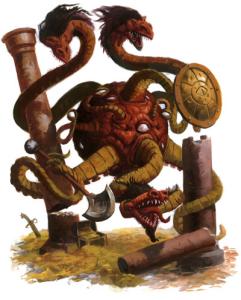
The Deepspawn had the potential to be one of the truly iconic weird monsters of Dungeons & Dragons, but somehow it remained limited to Forgotten Realms and didn’t really make any appearance after 2nd edtition. It’s on the cover of Lost Empires of Faerûn, but I think that’s it. When I first got into D&D with the Forgotten Realms campaign setting box (the 3rd edition FRCS had not been released yet), I thought that this creature was the fourth member of the exclusive group of aboleths, beholders, and illithids. But no it’s not, which is a shame. The deepspawn is a monster with a large spherical body over 5 meters in diameter and has six long tentacles. Three of the tentacles are used as arms, while the other three end in large maws full of sharp teeth. Its eyes are all over the body. The deepspawn by itself is not a terribly dangerous fighter and has only little magic abilities that would make any difference in a fight, but is completely immune to any poison and has a high resistance to magic. Its main ability is to spawn copies of any kind of living creature it has eaten, which takes between 1 and 4 day for each spawn. As a result, a deepspawn is never encountered alone but always surrounded and protected by a considerable force of other monsters it created. While the spawning ability is a bit dubious to me, I really do like its appearance and the idea that something like that would be the mastermind of a dungeon that rules over all the lesser monsters. The deepspawn got updated in Lost Empires of Faerûn, since the stats here are pretty shoddy. Size got increased from Large to Huge (which for a 5 meter sphere with long tentacles seems more correct), Strength got increased from measly 19 to 29 and Charisma bumped up from 4 to 10, which makes much more sense for something with Intelligence and Wisdom of 17. Now that looks a lot meaner, like something of this appearance should. Continue reading “Fantasy Safari: Monsters of Faerûn (D&D 3rd ed.), Part 2”
Fantasy Safari: Monsters of Faerûn (D&D 3rd ed.), Part 1
I have been given a number of interesting suggestions for more monster books, among them Creatures of Barsaive for Earthdawn and Creatures of the Dreamseed for Engel, which I am currently trying to hunt down. In the meantime, we’re going to explore Monster of Faerûn, the last Dungeons & Dragons book I have on my list of books I want to cover.
Monsters of Faerûn was one of the very early books for D&D 3rd edition and the first monster book after the original Monster Manual. The cover of the book matches the Monster Manual and not the Forgotten Realms Campaign Setting as all other Forgotten Realms books later would. It is also the only book that has the title “Monster Compendium” in it’s name. I assume it was planned to have it as a distinct product line, but all further monster books were 200+ pages hardcovers, unlike this 100 page paperback.
I started with fantasy stuff in 1999, the year before 3rd edition was released, and that start was Baldur’s Gate, the game that made BioWare the giant of Western RPGs that it had been for until recently. (Really not a fan of any of their games since Mass Effect 2, which is the best videogame of all time!) A game that just so happens to be set in the Forgotten Realms, so I had to get this book right when it came out. And even though it’s by far the smallest monster book ever released by WotC, and also just the second they made, I think this one really the best one by a far margine. When I went to get the monster pictures from the old art archive from WotCs website (they are still up, but you’ll only get there through search engines), there was barely amy that I didn’t download. And most of those that I am not going to cover here aren’t boring, but they are either beefed up versions of monsters from the Monster Manual (cloaker lord, greater doppelganger) or I already covered them when I did the 1st edition Fiend Folio (bullywug, fire newt, giant strider, gibberling, quaggoth). Truly wonderful book and almost all of the creatures can be imported to other settings without problem. I think a good dozen of them directly inspired monsters for my own Ancient Lands setting. If this book were Star Wars, it would be The Empire Strikes Back.
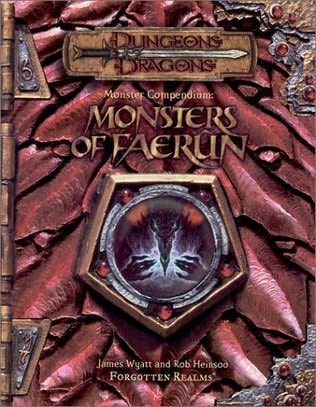
Monster Compendium: Monsters of Faerûn for Dungeons & Dragons 3rd Edition by Wizards of the Coast, 2001; 86 pages of monsters.
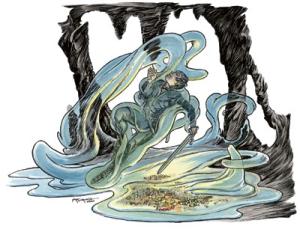
The Aballin is a type of ooze whose most distinguishing trait is that it looks just like water. It also can change between two different states, one being a thick slime, the other a water like liquid that is almost impossible to harm. It is one of the many classic creatures of the type “everything is trying to kill you”, but I think actually one of the less implausible ones. It’s just another slime like all the others, except that it has a clear color. When in its semisolid state, an aballin is quite strong and can slam enemies with considerable force. However its main mode of attack is to engulf its victim and simply drown him.
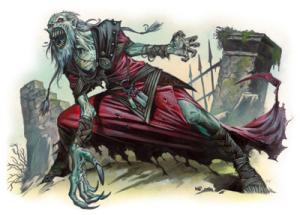
The Banedead is a variant ghoul created by clerics of the evil god Bane. One of their hands is a large claw, which also happens to be the holy symbol of Bane, and also deals 1 point of Dexterity damage. Which is not as measly as it sounds. Since it’s tied to a melee attack, there is no saving throw and there’s a good chance you’re going to encounter them in significant numbers. This can get quite bad over time, especially as banedead are not very strong otherwise and therefore likely to be fought by PCs of low-medium level. Dealing with larger numbers of them over several encounters could make for a very interesting adventure. An interesting detail of the banedead is that they are also created by priests of the Banes son Xvim, which tells us that this book was actually released before the FRCS, as from that point on Xvim is dead and Bane is back! (Variant Ghoul +1) Continue reading “Fantasy Safari: Monsters of Faerûn (D&D 3rd ed.), Part 1”
Fantasy Safari: Monster Manual (D&D 3rd Ed.), Part 4
Completing the Monster Manual:
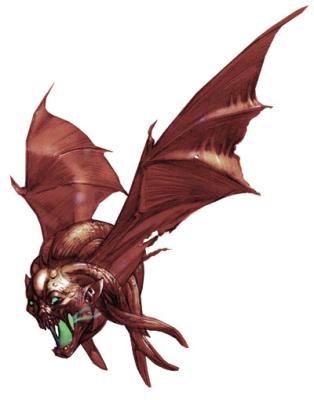
The Vargouille is a creature from before there were different creature types in D&D and eded up as an outsider in 3rd edition, even though it could just as well have been made undead like the bodak. As far as I am aware, they first appeared in the Planescape setting and they are a wonderful example of how the setting is full of things that are simultaneously silly, cool, and somewhat creepy. A vargouille is a humanoid head with a large pair of wings that has a terrifying scream that makes any creatures within 20 meters become paralyzed by fear. Their bite does very little damage, but also has a poison that makes it impossible for the target to heal any kind of injuries. But most terrifyingly, a vargouile can fly up to a paralyzed victim and give it a kiss, which starts a slow process of transformation that first makes the hair fall out, then the ears turn into large bat wings, makes it go insane, and finally causes the head to ripp off the neck and fly away as a new vargouille. Funny. But as always, some more description what you’re supposed to do with it would have been nice.
The Wight really is just a very beefed up ghoul. I like this monster and when you go into the details its background and context makes it a quite different creature. It’s still a starved corpse that sneaks around in the dark. (Variant Ghoul +1)
The Winter Wolf is a huge white wolf with who can breath icy cold and whose bite deals cold damage. Just like a color flipped hellhound. It’s bigger and tougher though, and also of human intelligence and with the ability to talk. They are not exactly masterminds, but are smart and dangerous enough to be villains in their own right who command weaker creratures as their minions. (Demon Dog +1)
And of course the Worg, because Tolkien did it. And everything that Tolkien did has to be in D&D! Its a big wolf that is slighly intelligent and evil. (Demon Dog +1)
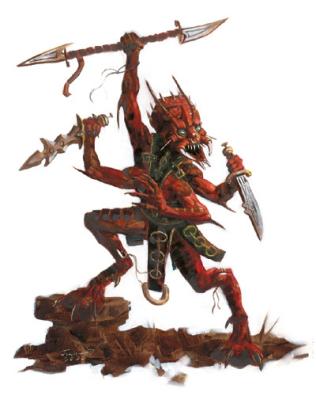
Xills are creatures that come from the novel Voyage of the Space Beagle, which also got us the displacer beast. It’s a four armed, demonic looking humanoid, but it’s actually from the ethereal plane. Unlike most ethereal monsters, it takes a xill significantly longer to move between the ethereal and material world, which makes impossible to quickly blink in and out and avoid any retaliation by its enemies. They are very intelligent and also evil, and as a nice thouch we’re also told that groups are often led into battle by a cleric of a deity of strength and travel. Their four arms help them with wrestling their enemies and when they can get a hold, they use their poisonous bite that can paralyze for several hours. The saving throw to resist it is not too high and there’s a good chance to withstand the poison, but then the xill can just try again the next round until it works. Unlike other monster (foreshadowing!) their ability to grapple is not excessively high and they can not try to bite without grappling an enemy first, which makes the ability not too powerful, but still something that can add a nice touch to a fight. Especially when the xills want to take prisoners, which they do to implant their eggs into them. With a duration of 90 days until the eggs hatch, there is plenty of time to try to rescue those prisoners and get them help. If you make some more backstory and context for them, these could be quite interesting enemies for a campaign. Continue reading “Fantasy Safari: Monster Manual (D&D 3rd Ed.), Part 4”
Fantasy Safari: Monster Manual (D&D 3rd Ed.), Part 3
More Monsters from the Monster Manual.
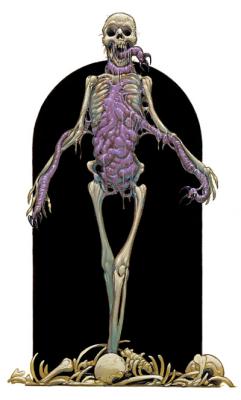
The Mohrg looks both icky and also pretty cool. It’s a human skeleton whose chest is filled with purple worms. It is however not a worm riding a human skeleton, but really a single undead creature that is created from a murderer who died unpunished. And it seems to be implied that it is the evil soul that makes the criminal return to unlife and not the work of a necromancer, which really raises the question where these worms are coming from? Perhaps the artist got unclear instructions what it should look like. A morg attacks both with its hands and its tongue, which in this illustration is also a worm. The tongue causes paralysis in living creatures, while it can also use the Improved Grab ability when it hits with its arms. Since humanoid ceatures never have the Improved Grab ability, I would guess the best way to describe it in combat would be to have the worms that are wrapped around the arm bones wrap around the target and hold it. The players sure would appreciate it. A mohrg is much more powerful than a skeleton and other than in appearance has nothing at all in common with those. When a creature is killed by a mohrg it raises as a simple zombie, but only after one to four days. Which in completely useless in combat, and you would have to add a lot of zombies to make a fight against a CR 8 monster more challenging. Considering all this, the writer who created the mohrg probably had much more in mind for it than just being a stronger skeleton to jump out from behind a corner and be killed in two to three rounds. This creature is really much better suited as the centerpiece of an entire adventure. One to four days is quite some time in which a lot can happen to a corpse. The mohrg might take it back to its lair and wait for it to rise, or it might be left where it fell. Or it might even have been found and already burried in the graveyard or being prepared for burrial. Suddenly, zombies! Zombies everywhere! A great investigation adventure which at the end will come together with a fight against the mohrg itself. Which being a murderer in life, should also have some backstory to go along with. This is exactly the kind of hidden information I am looking for in these books. Monsters that are much more than something to encounter standing in a dungeon room and to be forgotten four rounds later, but are actually made to have adventures created around them. And I must ask, why doesn’t this book spell this out?! This book is 15 years old, I had it since it first came out, and I have been using it countless times. And only now, carefully disecting each obscure monster and searching for tiny details that might be used as plot hooks, did I ever notice it? “1d4 days” is only seven characters, but they make all the difference. Why hide it? Would it have been so hard to add two more sentences to the description? Imagine if they had made that effort for all monsters in this book? D&D would be a completely different game than it is today and not the rules obsessed tactical combat simulation that it became.
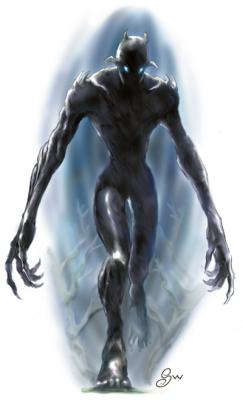
Do I have to say it again? I probably shouldn’t, but I’ll do anyway: This Nightshade illustration is fucking awesome! Like almost all Sam Wood illustrations in this book. The perspective makes it clear that this is a not a human sized guy and when you check the description it’s fucking huge. Not just big, but size category: Huge. A 6 meter tall bastard of pure darkness with blue glowing eyes. Nightshades come in three variants, the nightwing (huge bat), nightwalker (huge man), and nightcrawler (gargantuan worm) and are from the Known World setting of BECMI. Which I think is the reason for its biggest flaw. In BECMI, character levels go all the way up to 36, almost twice as high as the maximum of 20 in the 3rd edition core rules. Unfortunately, when converting the creature this difference was apparently not accounted for making the nightshades pretty high level creatures with a CR of 16 for the nightwalker. Which means I never got any opportunity to use it. Let me get my soap box, I think I need it today. I hate high level play in D&D. My campaigns usually don’t go any longer than 3 years and almost all of them start at low levels, because I very often get lots of people to play who never played any RPGs before. And since I don’t run dungeon crawling grind-fests, I’ve never seen any PCs of a level higher than 8th, either as GM or as player. And the way D&D is set up, that meant a huge amount of content never could be used at all. Like this cool badass bastard. Today I know better and could just rebuild him as a CR 8 creature and use that, but I used to be a young and stupid GM and that never really occured to me. I am afraid I don’t have much to say about the monster itself. There isn’t really any description what it is and what it does, and the abilities don’t seem interesting either. But damn, it looks cool.
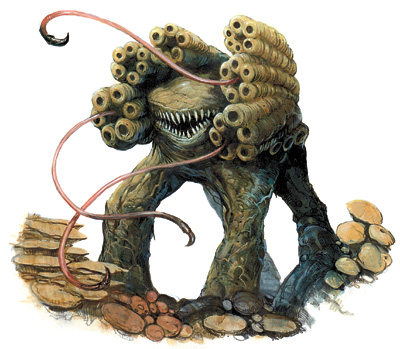
The Phantom Fungus looks very weird and kinda stupid in this illustration. Which doesn’t actually matter because it’s completely invisible almost the entire time. The stats for this monster are really very simple. It’s medium size, has animal intelligence, and is only CR 3. It’s natural invisibility is the only ability it has. Actually, you could just ignore the illustration since none of those things on its back or the tentacles coming out of them are doing anything. It is permanently invisible, walks up to you, and bites. Clearly the artist thought that this is totally boring and painted something much more interesting, if stupid looking, instead. The invisibility really is its only thing. I think the best idea is probably to just take this ability and add it to other creatures and make some really interesting monsters. Continue reading “Fantasy Safari: Monster Manual (D&D 3rd Ed.), Part 3”
Fantasy Safari: Monster Manual (D&D 3rd Ed.), Part 2
Continuing with the Monster Manual. And what a weird bunch of critters we have.
I think the Ethereal Filcher is hands down the weirdest thing to ever appear in any D&D book. This beats brain collectors and pherims by a long shot. As their name indicates, ethereal filchers are creatures from the ethereal plane, a place that is often mentioned in D&D but to my knowledge never really explored in any way. Mostly because it’s supposed to be almost entirely empty and featureless, I believe. The filcher is one attempt to add something to that plane, and I think we have to consider it a complete failure. They actually live in very hard to reach caves on the material plane, only moving through the ethereal plane to get in and out of their lairs and to sneak up on their prey. What they do is using their natural ability to sense magic to find people carrying magic items. Then they pop out from seemingly nowhere, grab the item, and return back to the etheral plane. Which really sounds like a terrible monster to use in your game. A group of 3rd level characters should have no ways to track or follow the ethereal filcher in any way and any item it gets a hold on is almost certainly gone forever. This just sucks. No wonder they were never used for anything to my knowledge.
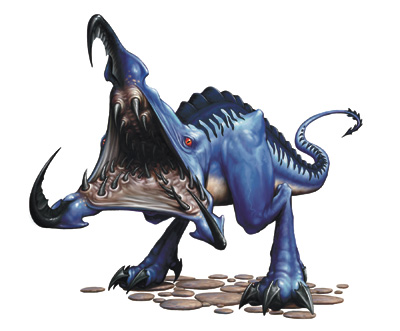
The Ethereal Marauder is another creature from the ethereal plane and actually native to that place. It also does not look nearly as insane as the ethereal filcher. It is also not much better as a monster, though, as it uses the same trick of popping out from nowhere, delivering a bite against their prey, and disappearing again until their target is dead. There isn’t really anything 3rd level characters could do about it other than readying an action, but as a GM, I would not allow players to say “I attack the thing when it pops up again in any of the six squares next to me”. At the very least you’d have to specific the space you are targeting and in that case the marauder just pops up behind your back.
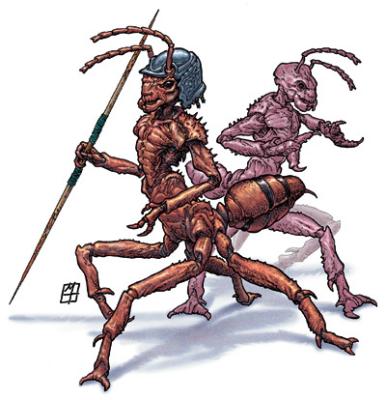
I believe Formians are a race that originates in Planescape, or at the very least had their greatest appearance in that setting. I think they have something to do with the border between the lawful outer planes of Mechanus and Arcadia, but nothing else is said about this in this book. They are still described as agressivelly expansionist, trying to create new colonies everywhere and taking control of every place they come to. There are several different types of formians, ranging from the small and quite weak workers to the very powerful myrmarchs and of course the magnificent queens. All formians within a 50 mile radius of the queen are always in telepathic contact with each other, making it almost impossible to surprise them or infiltrate their lairs. If one of them sees you, all of them know you are there instantly. Formians have various magical abilities depending on their rank. While workers are pretty weak and harmless, groups of them can work together to cast the spells cure serious wounds and make whole unlimited times per day, so any damage adventurers may cause to a colony will be very quickly repaired. Unless a formian is outright slain in battle, it will be back at full strength a few minutes later as long as workers can get to them. Taskmasters not only control formian workers and warriors, they also have the ability to telepathically control almost any kind of living creature and will almost always be accompanied by bodyguards of some other race. Myrmarchs have even more powers than that and the queen of a hive is always a sorcerer of at least 17th level. Even though workers and warriors are not very strong or dangerous by themselves, it is very unlikely that players will just run into a small group of them. Formians will almost always be encountered as a complete hive that at the very least consists of several dozens of warriors and hundreds of workers. And given their extremely effective organization they are also significantly more dangerous than just their individual numbers. If you’re using formians as opponents for your campaign and you are using them as described, it almost certainly should be as a major threat and the centerpiece of the whole adventure, most likely for pretty high level characters of 15th level or above. Continue reading “Fantasy Safari: Monster Manual (D&D 3rd Ed.), Part 2”
